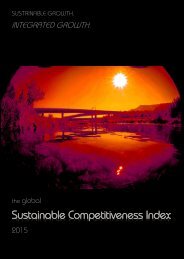Global Competetiveness Report
Create successful ePaper yourself
Turn your PDF publications into a flip-book with our unique Google optimized e-Paper software.
Country Rankings<br />
Sustainable Innovation & Competitiveness<br />
Sustainable Innovation<br />
Country Rank Score<br />
Dominica 89 37.1<br />
Moldova 90 37.1<br />
Indonesia 91 37.0<br />
Angola 92 36.3<br />
Botswana 93 36.2<br />
Hungary 94 36.1<br />
Seychelles 95 35.7<br />
Turkmenistan 96 35.4<br />
Vietnam 97 35.4<br />
Albania 98 35.2<br />
Ghana 99 34.6<br />
Macedonia 100 34.6<br />
Dominican Republic 101 34.6<br />
Egypt 102 34.0<br />
Burma 103 33.9<br />
Afghanistan 104 33.6<br />
Equatorial Guinea 105 33.5<br />
Nepal 106 33.4<br />
Qatar 107 33.4<br />
Laos 108 33.3<br />
Morocco 109 32.8<br />
Panama 110 32.5<br />
Timor-Leste 111 32.4<br />
Namibia 112 32.3<br />
Zambia 113 32.1<br />
Thailand 114 32.0<br />
Azerbaijan 115 31.6<br />
Republic of Congo 116 31.5<br />
Bahamas 117 31.4<br />
Gabon 118 31.4<br />
Mexico 119 31.2<br />
Philippines 120 31.2<br />
Jamaica 121 31.2<br />
Pakistan 122 30.5<br />
United Arab Emirates 123 30.3<br />
El Salvador 124 30.2<br />
Belize 125 30.1<br />
Swaziland 126 29.9<br />
Nigeria 127 29.6<br />
Cambodia 128 29.6<br />
North Korea 129 29.2<br />
Ethiopia 130 28.7<br />
Tanzania 131 28.5<br />
Rwanda 132 28.4<br />
In order to achieve sustainable development<br />
through innovation and competitiveness,<br />
countries have a number of tools at their<br />
disposal. However, there is no one-size-fits all<br />
solution. Policies have to be designed<br />
intelligently and specific to the circumstances<br />
and characteristics of a country:<br />
• Increasing budget allocation for<br />
education, and raise incentives for school<br />
attendance. However, increasing financial<br />
allocation alone is never sufficient without<br />
careful and localised planning<br />
• Formulate policies and incentives to<br />
increase allocation for R&D in areas key to<br />
the countries characteristic. In many Asian<br />
countries, formulating strategic industrial<br />
development priorities on the national<br />
level (not in the private industry) has shown<br />
to be highly effective<br />
• Protective measurements: development of<br />
protective measurements for key national<br />
industries areas (including agriculture) to<br />
allow the national industries to reach<br />
international competitiveness before<br />
competing on global markets<br />
• Increase allocation for the development of<br />
modern and intelligent infrastructure<br />
(which has the positive side-effect of<br />
creating employment in countries with<br />
high unemployment) to kick-start the<br />
economy. However, developing prestige<br />
projects that often turn into white<br />
elephants and investment ruins is a waste<br />
of time & money<br />
• Eradicating corruption on all levels.<br />
• Cutting unnecessary bureaucratic and<br />
administrative obstacles for businesses.<br />
• Regulating and attaching conditions to<br />
the flow of international capital<br />
52<br />
The <strong>Global</strong> Sustainable Competitiveness Index








